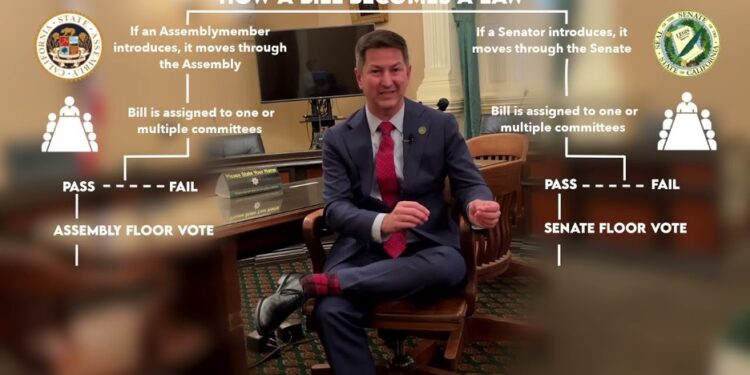Hello, Assembly District 78! My legislative package for this year has been finalized and my bills are starting to move through the legislative process. I wanted to take a minute this month to outline the lifecycle of a bill, so you have an understanding how state bills do or don’t become laws in Sacramento, and how you can provide your feedback at the right times.
The first step for Assemblymembers and Senators is to send their policy idea to the Legislative Counsel where state code language is drafted that specifies how the policy would be implemented. After that, the bill is ready for introduction. When the lawmaker is ready, he or she delivers it to the Chief Clerk or Secretary who then assigns the policy a bill number – say, AB 123.
Now, Assembly bills are assigned to one or more policy committees in the Assembly depending on the issue areas covered. Senate bills start in the Senate. Committees typically have several members who vet each bill for merits and potential issues and hear from the bill’s author on why the legislation is needed. The members can also suggest changes to the bill the author can accept or reject. The committee then votes on whether to move the bill forward.
These committee meetings are crucial steps in the legislative process and where your input is valued. Public feedback is important –– not just for those who oppose a bill, but also for those who support it.
Now this is important: You can provide your voice in-person in Sacramento, or by emailing or calling my district office where we will log your position which is sent to me by my staff ahead of votes. There is a portal on my website you can provide comment on any bill.
Incidentally, we have 33 policy committee areas across the Assembly and each member is typically assigned to sit on about five of those. My assignments are Housing and Community Development; Transportation; Labor and Employment; Water, Parks and Wildlife; and the Natural Resources committees. If a bill goes through any other committee, I don’t have a chance to weigh in until a floor vote – if it makes it there at all.
Once it passes out of all committees, it will then go on to the full house for a vote to move forward. As a personal rule, I do not take premature positions on any legislation until it comes time for me to vote. That way, I have all the time necessary to weigh public input and look for possible improvements a bill might receive along the way.
Once a bill is approved by the full Assembly, or Senate, it then moves to the opposite house to go through the same process all over again during the summer months. In the fall, if it passes both houses, the bill is ready to head to the governor’s desk for a signature where he or she has 30 days to sign it into law or veto it.
LEGISLATIVE UPDATE
Now – with my legislation introduced, I wanted to take second to highlight a few of my bills up for debate: AB 251 would direct the California Transportation Commission to study the relationship between vehicle weight and injuries to vulnerable road users, such as pedestrians and cyclists, as well as the costs and benefits of imposing a passenger vehicle weight fee to fund road safety features. A wealth of research is linking the increased injuries we see to vehicle weight, and California could join 14 other states in using a weight fee to support infrastructure and reduce accidents.
To address the housing crisis, I’ve introduced three bills that aim to make it easier to build homes. AB 671 will allow a community land trust to purchase residential property and construct accessory dwelling units to provide more affordable housing properties. AB 515 allows refinancing or sales of HCD financed projects to turn loan repayments into affordable housing opportunities. And AB 84 allows property owners to receive the welfare property tax exemption at the time of purchase for land developed and used for low-income housing.
As always, I want to thank you for your support. I’m grateful to be your representative and work on these issues and more. One of the best ways to stay informed is to follow my social media accounts on Facebook, Twitter and Instagram where you can know in real time what developments are happening or what I’m working on every day.
And if you need assistance, please know that my district office staff is available and ready to serve or answer any questions I wish you, your family and your neighbors all the best.









